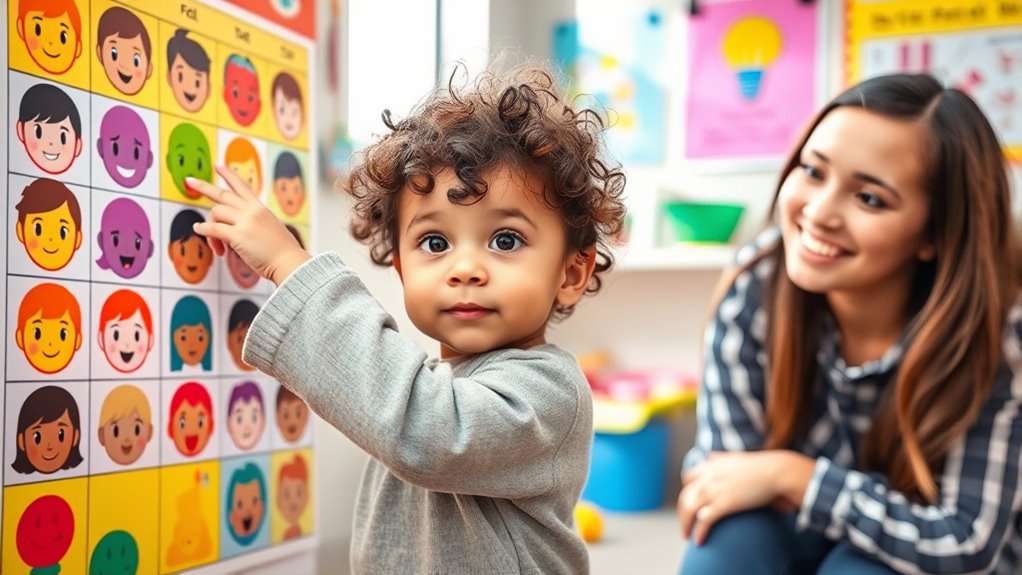To help your child identify feelings, start by encouraging them to notice and describe their emotions through mindful activities like deep breathing and observing feelings without judgment. Use everyday conversations and visual aids, like emotion charts, to reinforce recognition and labeling. Practice empathy by role-playing and discussing others’ feelings. Creating a supportive environment and consistently practicing these strategies can strengthen your child’s emotional intelligence, and if you keep exploring, you’ll discover even more ways to nurture their emotional growth.
Key Takeaways
- Use everyday conversations and visual tools like emotion charts to help children identify and label their feelings.
- Engage in mindfulness activities, such as breathing exercises, to increase emotional awareness and self-control.
- Practice empathy through role-playing and perspective-taking to foster understanding of others’ emotions.
- Encourage open discussions about feelings, validating all emotions to promote honesty and emotional recognition.
- Create a safe, supportive environment that nurtures patience and consistent practice of emotional skills.

Have you ever wondered why some kids seem better at handling their feelings than others? The difference often lies in their ability to recognize and understand their emotions. Developing emotional intelligence is an essential skill that helps children navigate social situations, manage stress, and build strong relationships. One effective way to foster this skill is through mindfulness activities. These activities encourage your child to pause, breathe, and observe their feelings without judgment. For example, you might guide them through simple breathing exercises, asking them to focus on their breath or the sensations in their body. Over time, this practice helps them become more aware of their emotional states, making it easier to identify what they’re feeling before reacting impulsively.
Mindfulness activities help children recognize and understand their emotions more effectively.
In addition to mindfulness activities, empathy exercises can considerably boost your child’s emotional awareness. These exercises involve encouraging your child to see things from someone else’s perspective. You could role-play situations where they imagine how their friend feels after losing a game or how a family member might feel when they’re upset. This practice not only teaches kids to recognize others’ emotions but also fosters compassion and understanding. When children learn to empathize, they become more sensitive to their own feelings and better equipped to express them in healthy ways.
Helping your child identify their feelings also involves talking about emotions openly. Use everyday moments to ask questions like, “How did that make you feel?” or “What were you feeling during that time?” When kids articulate their emotions, it reinforces their ability to recognize and label what they’re experiencing. Make sure to validate their feelings, even if they seem minor or confusing. Validating their emotions shows them that all feelings are okay and important, which encourages honesty and self-awareness.
You can also incorporate visual aids, like emotion charts or feeling faces, to make identifying feelings more engaging. These tools help children connect words with specific emotions, making it easier for them to express themselves accurately. Additionally, hydrocolloid patches can serve as a calming tool during emotional distress, providing a physical focus that promotes self-soothing. Remember that patience is key; children are still learning, and their ability to name and understand feelings develops gradually. By consistently practicing mindfulness activities, engaging in empathy exercises, and creating a safe space for emotional expression, you set the foundation for your child to become emotionally intelligent. Over time, they’ll gain the skills to recognize their feelings, understand others’, and handle their emotions more confidently.
Frequently Asked Questions
How Can I Teach My Child to Recognize Subtle Emotions?
To teach your child to recognize subtle emotions, start by encouraging them to read facial cues and recognize body language in others. Point out small changes in expressions or posture during conversations, and ask questions like, “How do you think they’re feeling?” Practice observing emotions in different situations. Over time, this helps your child become more perceptive and confident in understanding nuanced feelings.
What Are Age-Appropriate Activities for Developing Emotional Intelligence?
You can boost your child’s emotional intelligence through age-appropriate activities like play-based learning and storytelling activities. These activities encourage your child to express and understand feelings in a fun, engaging way. Play-based learning helps them explore emotions in real-life scenarios, while storytelling activities allow them to identify and empathize with characters’ feelings. Both methods promote emotional awareness naturally, making learning about emotions enjoyable and effective.
How Do I Handle My Child’s Intense Emotional Outbursts?
Imagine you’re guiding a stormy sea, calming turbulent waves. When managing tantrums, stay calm, acknowledge your child’s feelings, and set emotional boundaries like sturdy lighthouses guiding ships safely. This helps your child feel secure and understood. Use gentle words, offer comfort, and avoid punishment. Over time, your steady presence teaches them to navigate intense emotions, turning storms into peaceful waters.
When Should I Seek Professional Help for My Child’s Emotional Development?
If your child shows signs of severe emotional struggles or persistent behavioral issues that don’t improve with your support, it’s time to seek professional help. You should consider consulting a mental health expert when their emotions interfere with daily activities, relationships, or learning. Trust your instincts—early intervention can make a significant difference. Don’t hesitate to reach out if you’re worried; professionals can provide tailored strategies to support your child’s emotional development.
How Can I Encourage Empathy in My Young Child?
To encourage empathy in your young child, start by sharing stories that highlight caring and understanding. Use these moments to discuss how characters feel and why they act kindly. Model kindness yourself by showing compassion in everyday interactions, as children often imitate adults. Encourage your child to contemplate others’ feelings, ask questions about how they’d feel, and praise their empathetic responses. This active approach helps nurture their natural sense of empathy.
Conclusion
By helping your child recognize and understand their feelings, you’re planting the seeds for a garden of emotional intelligence that will flourish over time. Remember, guiding them through their emotions is like giving them a compass to navigate life’s storms. With patience and consistent support, you’re shaping a resilient, empathetic individual who can face challenges with confidence. Your efforts today are the roots that will grow into tomorrow’s strength and wisdom.









